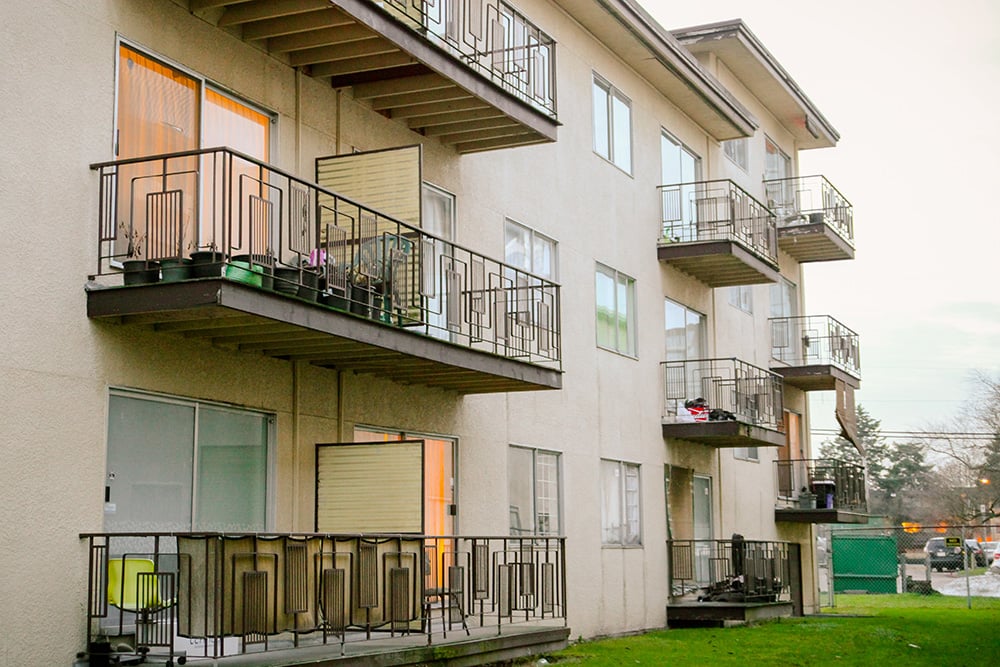[Editor’s note: An extended version of this article originally appeared in Policy Note.]
Housing policy has a democracy problem. Amid a housing crisis, highly unrepresentative public hearing processes contribute to land-use decisions that fail to reflect the perspectives and interests of all affected residents. But the right reforms can help deepen democracy and break housing gridlock.
At the municipal level, decisions about providing new housing are typically made on the basis of lengthy site-by-site rezoning and public hearing processes. This system of decision-making falls short on democratic grounds, and it makes building new homes more difficult and expensive for public, non-profit and private housing developers alike, contributing to the housing shortage in B.C. and Canada.
Public hearings on housing systematically underrepresent the interests of renters and those who have been priced out or otherwise excluded from communities. This problem is increasingly recognized and studied in cities across North America. Public engagement should take a more representative and deeply democratic form, and one that is consistent with rapid action to address the housing crisis.
Who public hearings serve — and who they leave out
As is typical in North American jurisdictions, public hearings are a regular feature of local decisions about land use relating to new housing in B.C. Provincial law sets the overall legal framework for municipalities including legal requirements for local governments to hold public hearings in certain circumstances.
Public hearings are legally required when changes are made to a community plan or zoning bylaw, including rezonings. An exception is that, under the Local Government Act, if a proposed rezoning is already consistent with the Official Community Plan, a public hearing is not legally required but is often held anyway. The City of Vancouver is subject to a similar but slightly different set of rules under the Vancouver Charter, wherein changes to zoning bylaws always require a public hearing even if they are already consistent with the Official Community Plan.*
Some forms of public engagement are held at the discretion of municipalities in cases like zoning variances, as well as by local and senior levels of government to solicit broader policy input.
Existing community plans and zoning bylaws tend to highly restrict the types of housing they allow. Without the process of a rezoning and public hearing, most of a city’s residential land disallows apartments and allows only low-density housing like single-family homes or duplexes. In effect, this imposes the most expensive forms of market housing as the default use of residential land.
There is a growing recognition among researchers, housing advocates, non-profit developers and governments that this system of site-by-site rezonings and public hearings for apartments is broken — it fails to give voice to all those affected by these decisions and contributes to the housing shortage.
A recent expert panel report commissioned by the provincial and federal governments noted that this approach to land-use decisions tends to disproportionately “amplify the voices of groups opposing new housing at the expense of citywide objectives and affordability,” while “those who support or stand to benefit from new housing supply often do not attend public hearings to voice their views and priorities.”
Indeed, site-by-site rezonings and public hearings have structural features that lead to the underrepresentation of renters and skew participation towards opponents of new housing rather than supporters.
For any given rezoning application, existing homeowners in the area — worried about issues like construction noise or lower property values — are geographically concentrated, making it relatively easy to self-organize and mobilize against a proposed housing development.
In contrast, the benefits of new housing — such as easing the overall housing shortage and lowering upward pressure on rents — are diffuse among renters around a region and modest for any individual project, making it challenging for these beneficiaries to mobilize politically.
Renters priced out or excluded from a city are strongly affected by the scarcity of new housing. But these potential beneficiaries lack political standing in the cities they’re excluded from.
These dynamics can be self-reinforcing: wealthy enclaves that don’t build enough housing to meet demand see rents and prices rise, driving out renters and lower-income residents, further weakening the political standing of these groups.
How to improve the public hearing process
Part of the solution to unrepresentative public hearings is to move away from site-by-site rezoning towards decision-making at a more encompassing geographic scope. Within a municipality, this could mean a citywide land use planning process.
A broader scope of planning recognizes that renters across a city have an interest in whether apartments are allowed on the majority of residential land usually reserved for low-density, expensive market detached homes. Holding fewer but more geographically encompassing public hearings also means renters and housing supporters wouldn’t have to mobilize to back the provision of new homes on a project-by-project basis.
Vancouver Coun. Christine Boyle recently proposed allowing social and non-profit apartment housing to be built in all areas of the city without rezoning or public hearing, delegating the decision to city staff in a process akin to that for permitting construction of single-family houses.
Victoria’s city council recently passed a citywide policy that allows new buildings in previously single-family areas to be divided into up to six units, though the actual additional housing floor space permitted is modest.
Vancouver has also undertaken a long and winding multi-year citywide planning process, which is ongoing. But the “Vancouver Plan” will only inform the creation of a set of narrower area plans in the future, which would then seemingly still require individual project rezonings. This leads some to criticize it as “a plan to make a plan to make a plan.”
While homeowners’ advantages in terms of political mobilization may be most potent when it comes to site-by-site rezonings, they also extend to citywide politics.
Citywide politics also don’t give voice to renters and prospective owners who have been priced out or excluded from a city but would like to live there. Nor do they account for broader society or economy-wide ramifications of a housing shortage, driven in part by the accumulation of many highly localized decisions about land use.
For these reasons, there has been growing attention to the role that senior levels of government should play in shaping land-use decisions, recognizing they have society-wide implications. For example, Premier David Eby recently brought forward legislation that would see the provincial government take steps to ensure that municipalities create an adequate supply of new housing.
Under the new law, the province will work with cities to create ongoing assessments of the pent-up need for housing, make the resulting targets binding and, if needed, the province can intervene directly in land-use decisions if cities fail to meet housing needs. The premier also promised minimum standards for zoning in urban areas to allow at least three housing units on a lot, shifting the default land use to include options other than detached houses.
Senior governments in other countries have likewise increased their involvement in land-use decisions, including at the national level in New Zealand and at the state level in California. In Japan, land-use decisions have long been made at the national level. Federal proposals to nudge better land-use policies have been put forward by progressive U.S. politicians like Alexandria Ocasio-Cortez, Elizabeth Warren and Bernie Sanders.
Expanding the geographic scope of decision-making about housing and land use is helpful and can contribute to ensuring a broader set of interests are represented.
But it is not a complete solution.
A promising second step: the case for ‘mini-publics’
In addition to shifting the locus of decision-making, we need to rethink public engagement processes relating to housing at whatever geographic scope they occur. New and more representative democratic processes are needed to fully come to grips with the housing crisis, processes that can tap into the knowledge and creativity of citizens to deliberate and resolve some of the difficult trade-offs involved in land-use planning.
We see “mini-publics” as a promising tool to add to our collective repertoire. Mini-publics can be commissioned by governments, non-profits and academics to provide insights and judgements on a specific topic, which to date have included everything from electoral reform to climate change to workplace democracy.
The outputs of mini-publics vary based on their type and remit, though often include individual responses to survey questions or collective decisions. These are usually captured in a report shared with the commissioning body and, often, with the broader public to inform public discussions.
Mini-publics have several distinguishing characteristics that have the potential to contribute to more representative and informed public input on land use, all while being relatively efficient.
Rather than relying solely on self-selection — which, as we have seen, can lead to public hearings skewed towards groups like homeowners, older individuals and white people — mini-publics select participants through some form of democratic lottery.
This means that if 40 per cent of a city’s residents are renters and 60 per cent are racialized folks, then approximately 40 per cent and 60 per cent of the participants in a mini-public will be renters and racialized, respectively. The same logic applies to other characteristics like age, gender and income.
Mini-publics include a variety of practices to ensure that these participants, once selected and onboarded, can thoughtfully engage with each other about the topic at hand. They often include a learning phase, in which participants can read balanced briefing materials and hear from and question expert and stakeholder witnesses.
With the aid of trained facilitators, participants can have honest conversations with each other in both small-group and plenary sessions to make sense of this information in light of their own experiences. The broader public is often enabled to observe and, in some cases, contribute to mini-publics. For example, the Grandview-Woodland Citizens’ Assembly included a consultation phase in which assembly members received feedback on their initial work.
When compared to public meetings where participants self-select, mini-publics bring together a far more descriptively representative group of individuals. Mini-publics often help engender high-quality deliberation among these diverse participants, more so than in many other bodies.
This is the case even when participants tackle more complex topics.
Researchers have highlighted how participants in mini-publics make high-quality decisions based less on their own personal priorities and more on those of the broader community.
Getting from here to there
What could a transition toward the use of mini-publics in housing and land-use decisions look like? There are options for either local or provincial governments to move in this direction on their own, and action and co-operation at both levels of government could open up even more possibilities.
When it comes to Official Community Plan and zoning bylaw changes that legally require public hearings, municipalities could likely overhaul these processes even without changes to provincial statutes.
Although provincial law requires public hearings for these types of changes, it leaves municipalities with considerable latitude about how these hearings are organized. Key requirements are that persons who believe they are affected by the change be “afforded a reasonable opportunity to be heard or to present written submissions” and that at least one member of the local council be involved in the hearing.
This would seem to allow for a reorganization of public hearings along the lines of a mini-public as long as it included the opportunity for open submissions from the public as described above.
If public hearings had to be maintained largely in their current form, though, a mini-public could be convened in parallel as a more representative element of public engagement and input.
Better yet would be if the provincial government amended legislation to remove any ambiguity, explicitly allowing the use of mini-publics in place of the status-quo form of public hearings.
The province could also provide a model framework for how to conduct a mini-public for these purposes, which municipalities could use or adapt. Indeed, given how deeply flawed and unrepresentative public hearings are, a good case could be made for the province to simply require the replacement of self-selected public hearings with mini-publics.
In our suggested model, any interested residents could still make submissions about decisions on a self-selection basis, but this feedback would flow through the much more representative mini-public, which would serve as the hub for public engagement and input.
Finally, with or without legislative changes of these kinds, the province could convene its own mini-publics at provincewide or regional levels to address important housing policy questions. In addition to making substantive housing and land-use policy reforms at the provincial level, this could help demonstrate the potential of the mini-public model to interested local governments.
There is growing recognition that the current system of public engagement on land-use decisions is unrepresentative and inefficient. This system is failing on democratic grounds by amplifying the interests of only a subset of the population, as well as contributing to the severe housing crisis and shortage in B.C and much of Canada.
Mini-publics can help deepen democracy in relation to housing policy. Combined with expanding the geographic scope of decision-making, mini-publics can help better align land-use policies with the informed views of people from all walks of life and living circumstances.
This can help break the gridlock that for too long has been contributing to the housing crisis.
This post is a part of an ongoing research project into affordable housing funded by the Vancouver Foundation.
* Story updated on March 6 at 1:44 p.m. to include information on public hearings under the Local Government Act, which was originally omitted during for the Canadian Centre for Policy Alternatives, B.C. office’s Policy Note. ![]()
Read more: Rights + Justice, BC Politics, Housing, Urban Planning


















Tyee Commenting Guidelines
Comments that violate guidelines risk being deleted, and violations may result in a temporary or permanent user ban. Maintain the spirit of good conversation to stay in the discussion.
*Please note The Tyee is not a forum for spreading misinformation about COVID-19, denying its existence or minimizing its risk to public health.
Do:
Do not: